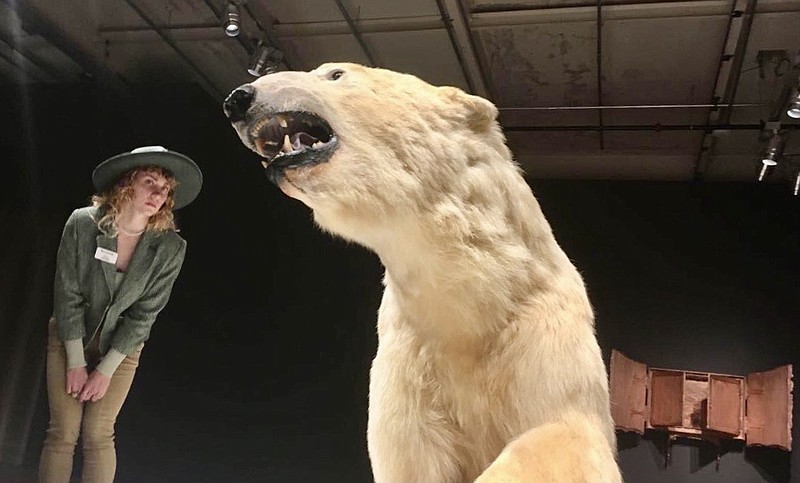BENTONVILLE — Think of the Momentary as the kicky younger sister to Crystal Bridges Museum of American Art. Maybe like Princess Margaret was to Queen Elizabeth in the '60s and '70s. While the Queen's primacy is undeniable, there were some parties she really couldn't attend. That's where Margaret came in.
The metaphor is imperfect, but maybe it captures some of the flavor of what the Momentary, Crystal Bridge's satellite arts space near downtown Bentonville "for visual, performing, and culinary arts," provides.
There's a coffee bar and an outdoor festival space, an auditorium for music, and a bar in a tower. The gallery space is suitable for the erection of temporary walls, and the 63,000-square-foot former cheese factory, which serves as the concept's physical plant, offers chambers of great volume as well as intimate rooms. It could probably accommodate a paintball war as well as the three exhibits that are currently open, for free, to the public until Sept. 25.
'A DIVIDED LANDSCAPE'
The first of these, "A Divided Landscape," features the work of seven contemporary artists in conversation — if not argument — with historical drawings and paintings from Crystal Bridges' collection that inform and define the conventional story of Manifest Destiny and American post-colonial expansion across the continent. It was organized by the Momentary and curated by artist/curator Neville Wakefield, who may be best known for his association with Desert X, a site-specific biennial exhibition of contemporary art held in California's Coachella Valley (the next Desert X is scheduled for March), along with the Momentary's associate curator Kaitlin Garcia-Maestas and curatorial associate Taylor Jasper.
And so we have the interesting juxtaposition of relatively new works such as Xaviera Simmons' "Composition One for Score A," a 2010 photograph of the artist, a black-clad figure in near silhouette with one hand on her hip as the other points into the distance toward a sandy mesa and beyond the frame to a painting on a nearby wall by Hudson River school painter Jasper Francis Cropsey.
Cropsey's 1858 "The Backwoods of America" is an idealized (and completely fictional) pioneer landscape that the artist painted in London, where he won the approval of famous critic John Ruskin who, according to a report in the Contemporary Art Journal, "at first could scarcely believe the brilliant combinations in this artist's autumnal sketches were anything other than exaggerations of 'Young America.'"
Cropsey's painting is exactly that, a wistful depiction of daybreak on a remote homestead on the shores of a wilderness lake. As a pioneer family begins its day, a frontiersman heads into the woods, an axe across his shoulder and faithful dog at his side. His wife watches from the doorway of a log cabin as their children play on the porch.
There are a couple of presumably lowing cows in the middle ground, and a rough vegetable patch. In the foreground are several pumpkins, which establish the scene as definitively American, and a toppled headstone signaling the imminent end of pioneer life (one enduring theme of American mythology is that the frontier is disappearing forever).
At the time he painted "The Backwoods of America," Cropsey was engaged in a patriotic (but not unselfish) mission to show his country to curious Europeans. He meant to present it in its best light — which was, according to fellow expatriate American painter Thomas Cole, "in autumn" — a season widely perceived in Europe as dour and dreary. Cropsey, Cole and Frederic Church were among a number of American painters who were spreading a kind of visual propaganda in Europe in the second half of the 19th century; they were from a place called America the Beautiful, a raw and natural place not yet exhausted by civilization.
The two paintings are consciously positioned so that Simmons — the artist as co-subject in her own work — seems to be interrogating Cropsey's whimsy. "Really!?" it seems to say. "Where is this pleasantly bucolic scene? Who are these people? Whose land was this? How did they get here?"
Removing the Cropsey from the relative safety of Crystal Bridges' galleries has rendered it vulnerable. Not only might it seem old-fashioned and quaint to an audience hip to Simmons' work, it might even be perceived as a manifestation of colonial privilege. "A Divided Landscape" puts the work in a critical context, asking us to think about the assumptions underpinning the common and wishful myths of the American frontier.
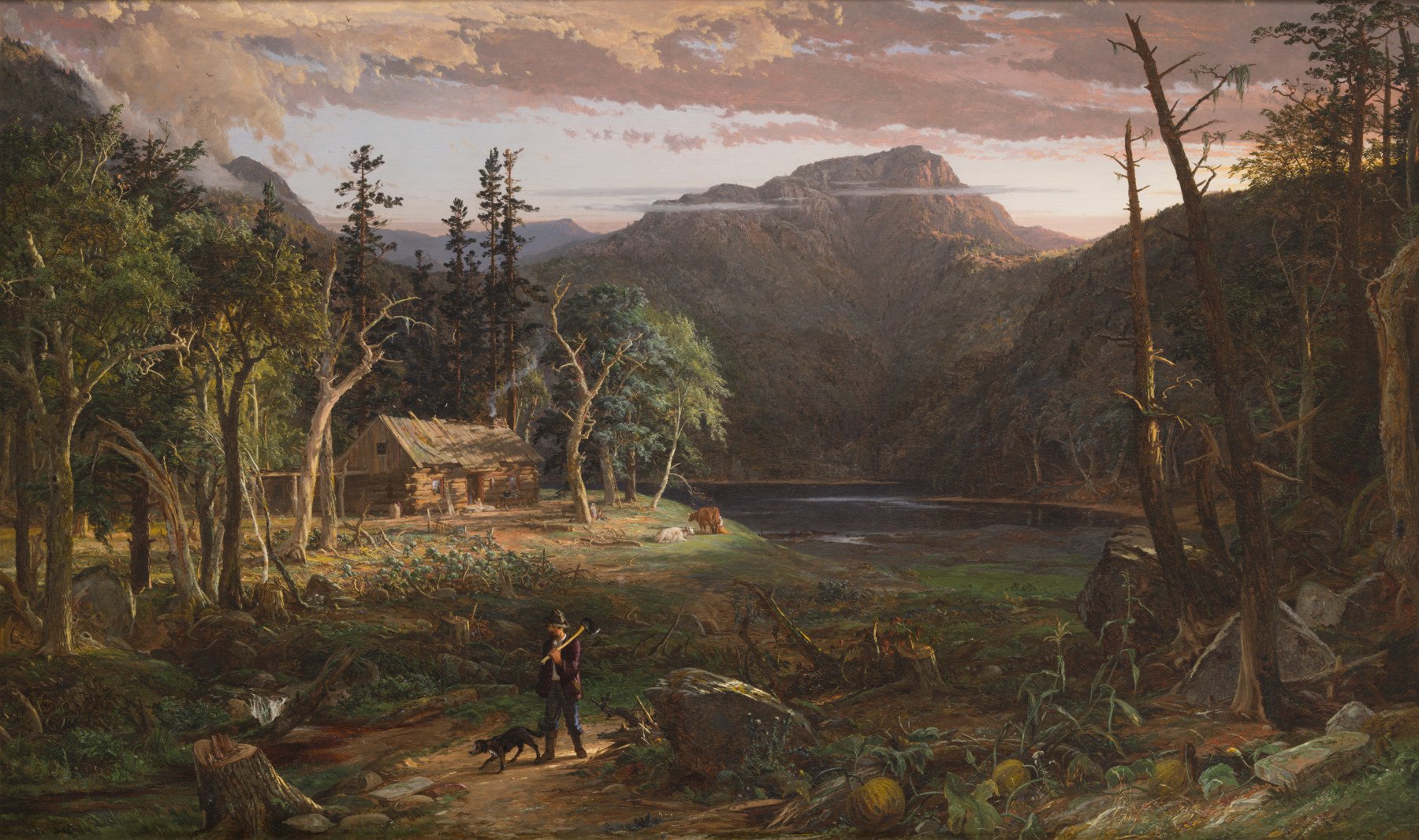 “The Backwoods of America, 1858” by Jasper Francis Cropsey, oil on canvas (Courtesy of Crystal Bridges Museum of American Art)
“The Backwoods of America, 1858” by Jasper Francis Cropsey, oil on canvas (Courtesy of Crystal Bridges Museum of American Art)
LOADED FOR BEAR
This dynamic continues in another gallery, where Arthur Fitzwilliam Tait's 1856 painting "A Tight Fix — Bear Hunting, Early Winter (The Life of a Hunter: A Tight Fix)" is mounted on a wall, facing a taxidermy polar bear that, according to Garcia-Maestas, was shot in the 1960s by "a white sport hunter who came to Shishmaref, Alaska, which is one of the towns that's currently melting into the sea."
Nicholas Galanin, a Tlingit-Unangax artist from Alaska, obtained the bear and turned it into his 2015 sculpture "We Dreamt Death," which seems to be crawling toward Tait's scene, which depicts a hunter in a snowy clearing about to do combat with a black bear. Galanin's bear is emaciated, and seems to be pulling away from a rug that is its eventual destiny.
Tait's bear might seem to have the upper hand in that the hunter he's engaging is armed only with a knife. But in the background a second hunter levels a rifle at the bear's head. He may prevail over his immediate enemy, but the humans' guns will win out in the long run.
Tait's and Galanin's work tease questions about the tensions between man and nature, but Garcia-Maestas points out that Tait's painting was also seen as allegorical, an allusion to the sorting of states into pro- and anti-slavery blocs. In 1856, civil war was imminent.
Galanin's work, meanwhile, has an obvious environmental subtext, with polar bears having become something of a mascot for the environmental movement. It continues the exhibit's theme of illustrating the consequences of depletion and human arrogance and indifference to the cost of extraction of natural resources.
The history of this bear is complicated — it was shot by an interloper on land that was sacred to the artist's tribe. And the frontier on which the bear was taken is literally disappearing.
The positioning of these works in proximity to one another feels like a conversation; perhaps Galanin's wounded bear is crawling toward Tait's doomed one to lend help? Maybe the hunter in the background will have to reload.
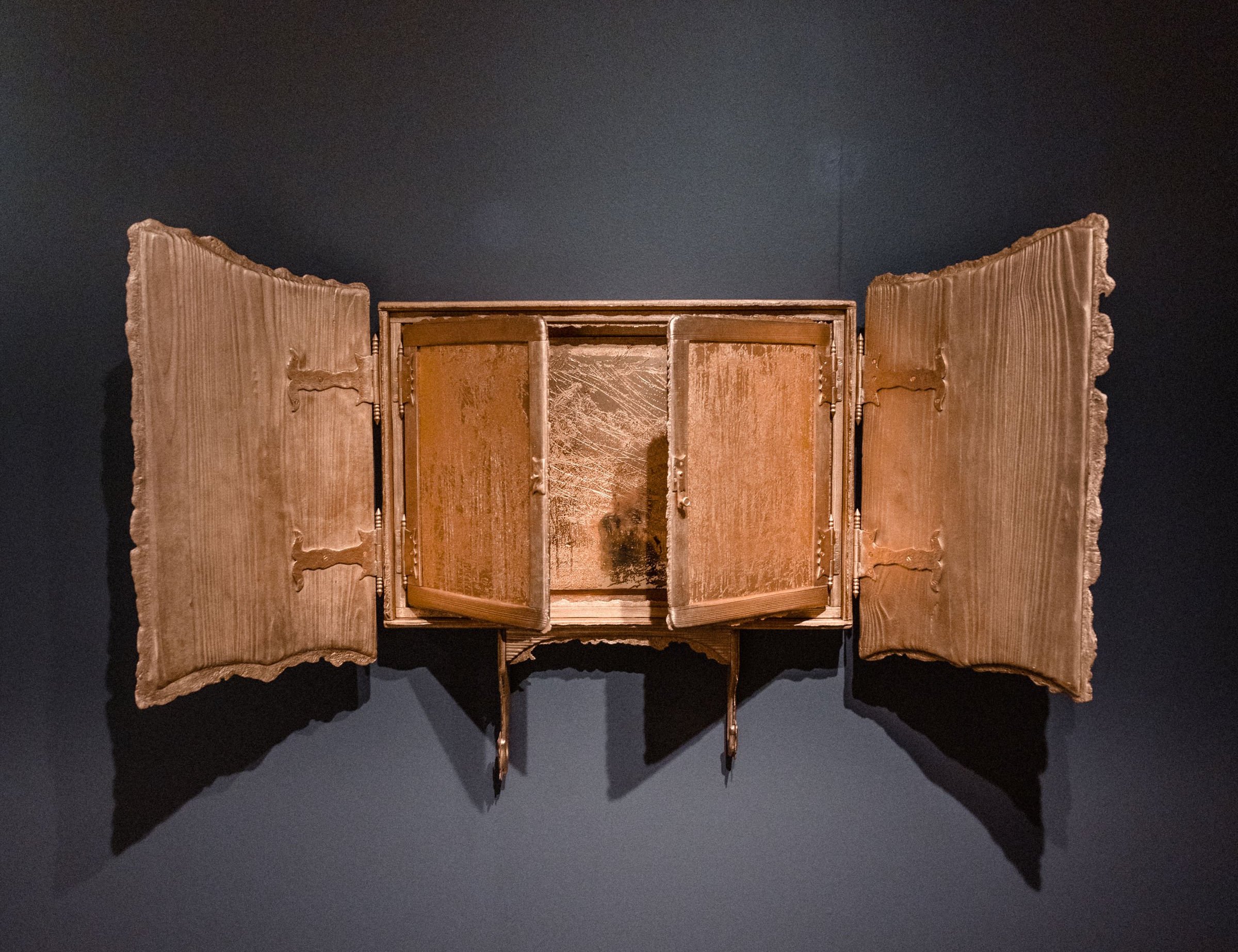 Matthew Barney’s “Redoubt,” 2018, is a work of cast and electroplated copper cabinet with electroplated copper plate. For summer 2022, Bentonville’s Momentary offers visitors the opportunity to experience art in all of the galleries as well as outdoor spaces on the campus with three exhibitions that include this piece. (Courtesy of Jared Sorrells)
Matthew Barney’s “Redoubt,” 2018, is a work of cast and electroplated copper cabinet with electroplated copper plate. For summer 2022, Bentonville’s Momentary offers visitors the opportunity to experience art in all of the galleries as well as outdoor spaces on the campus with three exhibitions that include this piece. (Courtesy of Jared Sorrells)
A 'HAPPY ACCIDENT'
Garcia-Maestas notes that from some angles, Galanin's bear is reflected in the protective vitrine placed over "A Tight Fix." This, she says, was a "happy accident"; when the curators were planning the exhibit, they didn't consider the effect of one artwork being superimposed on another. The vitrines were considered essential "for the preservation of the historic works, but what we're getting is ... these pretty incredible reflections of these indigenous artworks on top of these historical works ... which adds another conceptual layer ... ."
One of the fears that some might have had about Crystal Bridges before it opened was that it was to be primarily a repository for traditional American art such as that produced by the Hudson River School and wildlife specialists including Tait. That fear was unfounded, as the museum proved to be interested in all manner of American art, not just easily relatable pretty pictures. But it's borderline courageous for a museum to interrogate its own collection this way, to hold out a work like "A Tight Fix" (which to my mind is one of the museum's signal pieces) for reassessment.
And on the wall behind "We Dreamt Death" is a copper cabinet from Matthew Barney's 2019 film "Redoubt," a two-hour, 14-minute feature that loosely adapts the myth of Diana (to the Greeks, Artemis), the Roman goddess of the moon, wild animals and wilderness, transposing it to the Sawtooth mountains of Idaho and to a vaguely 19th-century milieu. (The film, which, largely through choreography, tells the story of Diana's pursuit and punishment of the hunter Actaeon, will be screened several times during the run of the exhibition. The next screening will be June 16.)
Barney — who may be best known in a popular context as the ex-boyfriend Bjork was singing and writing about on her break-up album "Vulnicura" (2015) — is perhaps the highest-profile artist in the exhibition, a polymath who works in sculpture, film, photography and drawing. Seven copper engravings he made for "Redoubt" are also featured elsewhere in the exhibit.
"The use of copper is really referencing the history of extraction ... in the American West," Garcia-Maestas says.
The rest of "A Land Divided" is equally interesting. Inside a curtained room, Kara Walker's devastating 12-minute, cut-paper shadow-puppet video "Prince McVeigh and the Turner Blasphemies" runs on a loop, cataloging the country's history of reactionary violence, touching on Timothy McVeigh's 1995 Oklahoma City bombing and the 1998 murder of James Byrd Jr.
On the other side of the building, Lucy Raven's film "Demolition of a Wall (Album 2"), a moving image installation consisting of color video, quadraphonic sound, wood and aluminum screen, and an aluminum seating structure, rattles and hums. Another Galanin work, a floral wallpaper-wrapped totem pole, stands sentry.
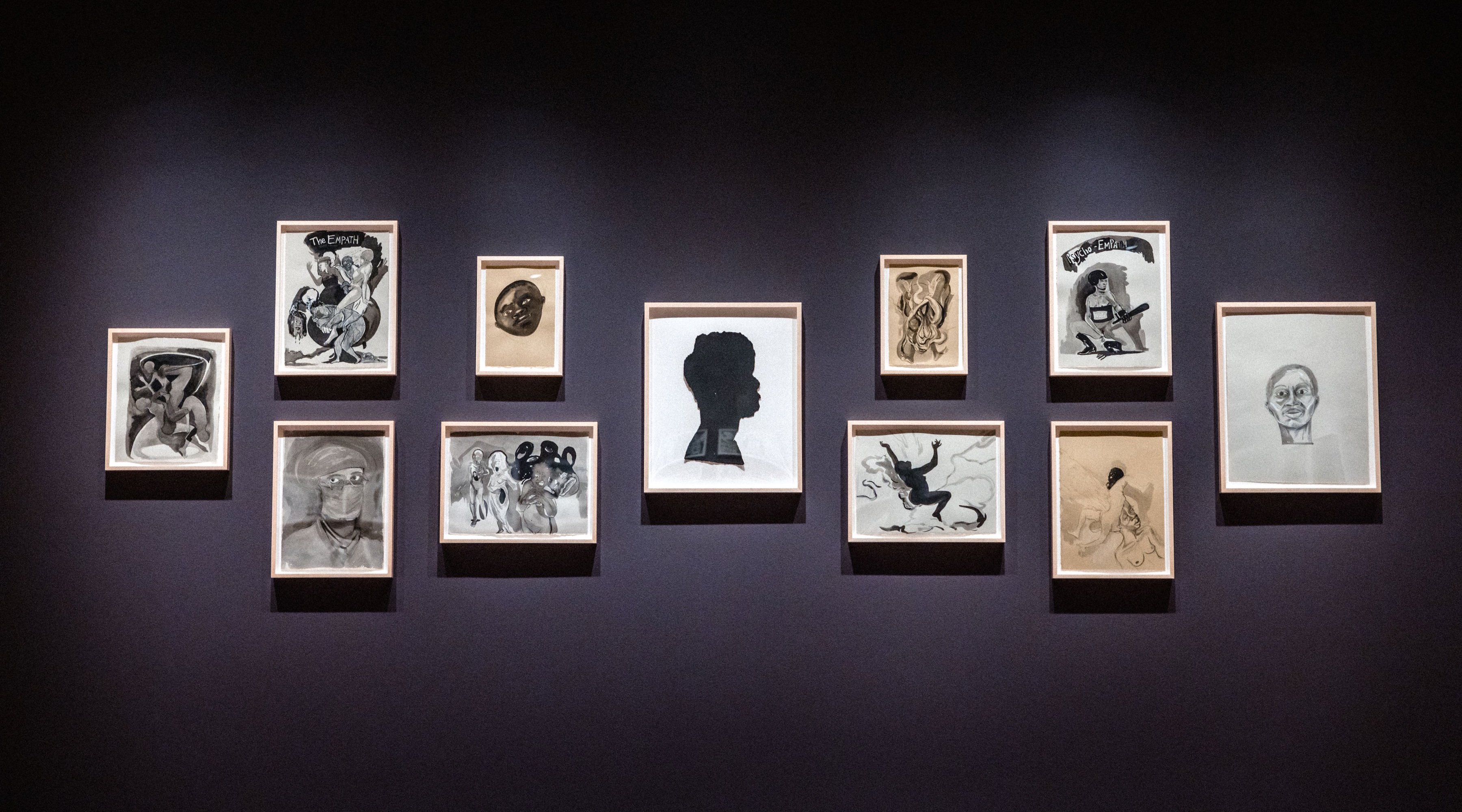 “Book of Hours (Self and other)” by Kara Walker, 2021; graphite, watercolor, gouache and sumi-e ink on paper (Courtesy of Jared Sorrells)
“Book of Hours (Self and other)” by Kara Walker, 2021; graphite, watercolor, gouache and sumi-e ink on paper (Courtesy of Jared Sorrells)
ESTEBAN CABEZA DE BACA
"Esteban Cabeza de Baca: Let Earth Breathe," on view in the lobby gallery and adjacent outdoor spaces at the Momentary, immediately presents an uplift from the dark and thinky mood of "A Divided Landscape." Cabeza de Baca, from the border city of San Ysidro, Calif., is also asking questions about the general assumptions of traditional American landscape art, but there's an inherent playfulness in his bold paintings, which are inspired by pre-Colombian pictographs.
Though he holds a master of fine arts degree from Columbia University, his large-scale acrylic landscapes somehow evoke a collaboration between Jackson Pollock and Howard Finster. There's a lot to look at in something like the 6-by-18-foot "Beaver Moon" (2022), which presents as the piece de resistance of his solo show.
The inviting ambience includes a community sitting space and an in-gallery seed library from which visitors can take packets of seeds for free. Outside are several site-specific installations conceived as collaborations with nature. A bronze sculpture planted with milkweed, echinacea and strawberries installed in late April has attracted native bees and monarch butterfly larvae.
Cabeza de Baca will teach a pottery workshop at 6 p.m. June 15 in the gallery at the Momentary, with participants making pots to hold seeds for vegetables, medicinal plants and pollinator-supporting species.
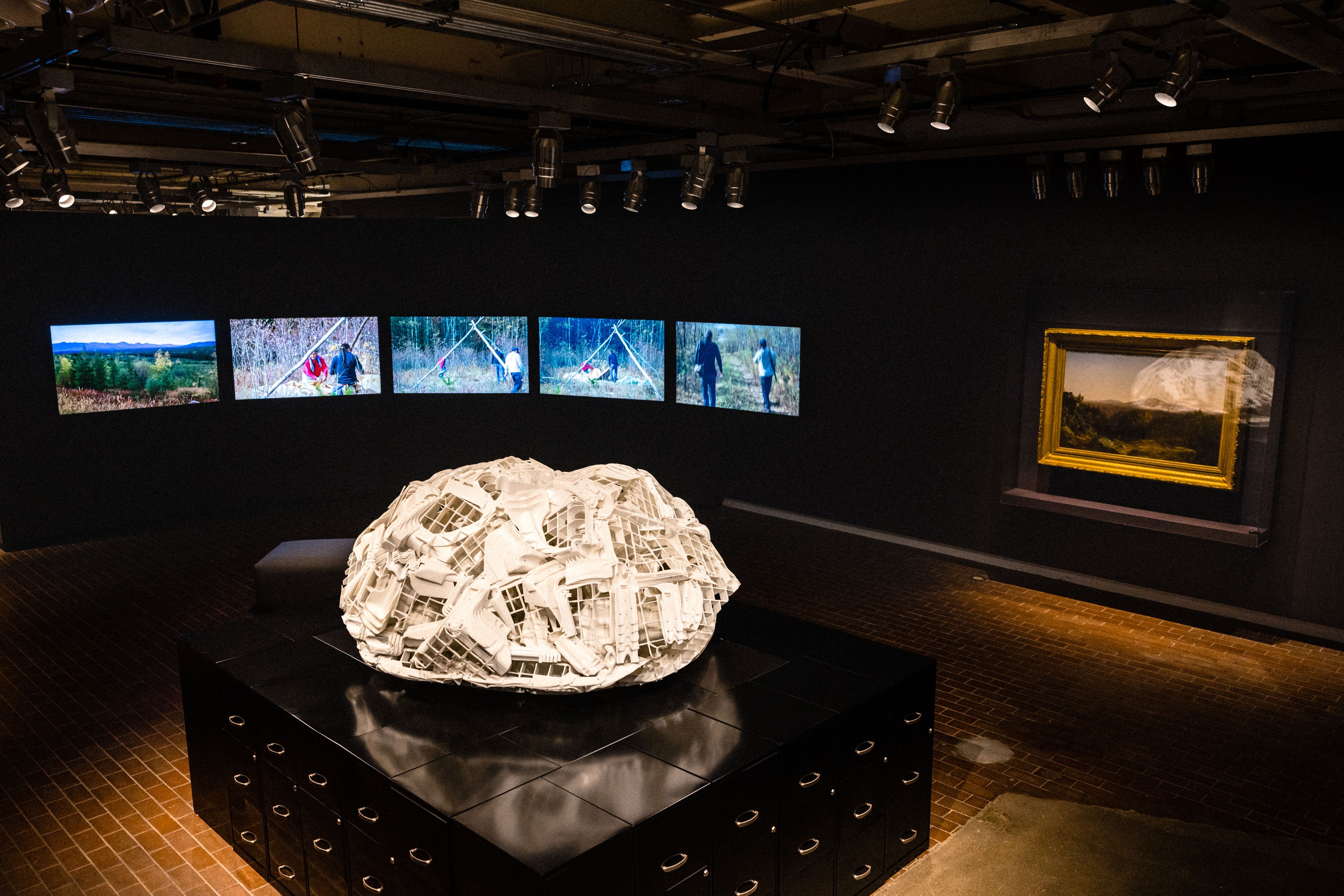 Brian Jungen’s “Tombstone,” 2019 (foreground), Rubbermaid step stools, filing cabinets and “Modest Livelihood,” 2011 (background, left), five-channel video installation, share space with John Frederick Kensett’s “View of Mount Washington,” 1852 (background, right), oil on canvas, at the Momentary. (Courtesy of Jared Sorrells)
Brian Jungen’s “Tombstone,” 2019 (foreground), Rubbermaid step stools, filing cabinets and “Modest Livelihood,” 2011 (background, left), five-channel video installation, share space with John Frederick Kensett’s “View of Mount Washington,” 1852 (background, right), oil on canvas, at the Momentary. (Courtesy of Jared Sorrells)
RASHAWN GRIFFIN
Kansas City, Mo.-based artist Rashawn Griffin spent several weeks in residency at the Momentary last year, considering the challenges presented by the space's architecture. His solo exhibition "Rashawn Griffin: we no longer recognize the backs of our hands," on display in Room 122 of the Momentary, is his answer to the question: "How can I paint this room without actually painting it?"
Griffin has created an immersive funhouse mirror space that at times reads less like an installation than a painting one can walk through.
The Momentary might not yet have the authority and cultural heft that its older sister has achieved in a short 10 years, but it is a fascinating and potentially revelatory laboratory space in which all sorts of disciplines, crafts and arts might be practiced and enjoyed.
To say it's the fun one is to mislead — Crystal Bridges can be a very fun place — but there is a certain insouciance to the Momentary that gives it a very specific, and very accessible, vibe.
Email: pmartin@adgnewsroom.com
